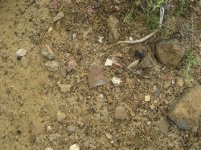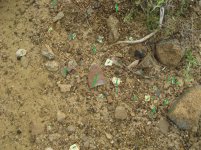You are using an out of date browser. It may not display this or other websites correctly.
You should upgrade or use an alternative browser.
You should upgrade or use an alternative browser.
Avon (Conn. Paleo)
- Thread starter uniface
- Start date
MosesOfTheSouth
Full Member
thanks uni. love reads like this.
joshuaream
Silver Member
Cool site, it sounds like it went pretty deep.
The vast majority of artifacts from archaeological excavations just aren't very photogenic (or even that interesting to collections.)
Just for an example, here is a broken point from my paleo site. The broken point is right in the center. There are probably 25-30 other artifacts in this picture, all of them being waste flakes and what looks like chunk of a core. Most of us, myself included most of the time, aren't going to count the individual flakes. Professional archaeologists, especially those with tax dollar funding, are going to count the flakes. And in the right context those flakes can be more "valuable" than a pristine finished point.

Here is the same picture where I marked some of the artifacts.

As a New Englander, this caught my eye when the story came out. Does anyone know how to see pics of the artifacts. 15000 and I’ve seen pics of a half dozen, what is our tax money paying for.
The vast majority of artifacts from archaeological excavations just aren't very photogenic (or even that interesting to collections.)
Just for an example, here is a broken point from my paleo site. The broken point is right in the center. There are probably 25-30 other artifacts in this picture, all of them being waste flakes and what looks like chunk of a core. Most of us, myself included most of the time, aren't going to count the individual flakes. Professional archaeologists, especially those with tax dollar funding, are going to count the flakes. And in the right context those flakes can be more "valuable" than a pristine finished point.

Here is the same picture where I marked some of the artifacts.

So if I understand correctly most artifacts look like regular old rocks. That is kind of what I thought, thanks for the reply.
No. Not regular rocks. Rocks that have been modified by man. There's a difference between a geofact and an artifact. Gary
Charl
Silver Member
Of the 15,000 artifacts mentioned, since this was a professional dig, I won’t be surprised if 14,900 are simply flakes. Flakes are counted, as they should be. They were produced via human activity, reveal lithic sourcing, etc. But, as Joshua pointed out, most of us would not be that interested in seeing flakes. Most of us don’t even collect them in our hunts, though I always collect exotic flakes and flake tools. Short video here:
https://www.nbcconnecticut.com/news...scovered-during-construction-in-avon/2194072/
https://www.nbcconnecticut.com/news...scovered-during-construction-in-avon/2194072/
Charl
Silver Member
So if I understand correctly most artifacts look like regular old rocks. That is kind of what I thought, thanks for the reply.
Most experienced collectors/artifact hunters can distinguish a flake from a “regular old rock”. I do have a close friend who is able to find points, but also, after many years, still collects rocks that he mistakes for artifacts. But, he is unusual in that respect, and in my experience. A flake is not a “regular old rock”. It was produced by human activity, knapping, and they are easily recognized, especially if a hunter is already familiar with the lithics used in his/her spots. I’ll grant that if someone with no experience were shown a pebble and a flake, their lack of experience would almost surely prevent them from realizing the flake resulted from human activity, and therefore different for that reason from the pebble.
Charl
Silver Member
Could still take pics of the 100 finished pieces and put them on the net.
Sounds like the firm hired to analyze the finds are more concerned with doing just that, over the next several years, than they are in being sure the general public sees photos of the finds. I still suspect they showed the most “photogenic” finds. Recall the base of the rhyolite point the various articles have shown. Just a guess on my part, but I’ll bet if they had a better example of a fluted point to illustrate what was found, they would have shown it. At any rate, this article let’s you see their trays of artifacts. Lol. I suspect nobody thought “we have an obligation to see to it that the general public see photos of each artifact prior to the completion of our study”. To be honest, just my opinion, but I would not feel that such an “obligation” was a requirement either, if I were them. Would not even occur to me. Show a few pieces, and then be about the business of analyzing the assemblage. Not for one second would I feel obligated to photograph and show every single artifact found prior to study. I’d be more concerned with completing an analysis, and publishing for my peers in the archaeological community, and not so much “let’s first be sure the public sees a photo of every “finished” piece”. But that’s me, I would not feel such an “obligation” at all.
https://www.courant.com/news/connec...0200126-ggnicuiagvc45nd2zyk4w54k5q-story.html
“Bags of promising soil were removed from the site, as were each of the 15,000 artifact fragments.Then, they were all carted back to an AHS facility in Storrs, where an intensive cataloging process is underway.
The team first washed or dry-brushed every piece brought back from the site, whether it was a small fragment of a scraping tool or the tip of a spearhead. Then, the team individually packaged each piece, logged it back into a larger group of artifacts and then entered it into a database with all of its existing data markers, plus additional data such as the fragment’s color, material and weight.
In mid-January, Leslie and Sportman said, their team was about halfway through the process of inventorying all of the artifacts.
After the inventorying is complete, everything will be reviewed and double checked. Finally, the pieces will be stored to prevent their decomposition or misplacement.”
You can contact them, and tell them you want photos of the artifacts from the Avon site, and perhaps explain why you feel they were remiss in not doing that in the first place:
https://ahs-inc.biz/
Last edited:
uniface
Silver Member
- Thread starter
- #12
So doing a job that would take maybe one hour of an intern's time, with another one (these days probably a junior high school kid) posting them is an outrageous expectation. Especially for an outfit publicly funded & thereby obligated to "educate the public."
uniface
Silver Member
- Thread starter
- #13
On second thought, in the big picture, withholding pictures of artifacts from excavations in the USA has been standard operating procedure for decades.
The pretext for this (site reports/news with no pictures) has been that this deliberate information quarantine is to deny "looters" (surface collectors & others interested in artifacts) information that would increase the market value of what they have. That this is a transparent lie is obvious from their reliance on avocational publications/websites/consultations to identify both the artifacts they unearth and the materials/sources involved.
(And in the absence of these you end up with idiotic nonsense like the recently posted explanation that the neolithic knappers in Yemen were making "fluted points" to "show off their knapping skills" when it's obvious from a casual glance that the purported "fluted points" were flake cores for making thin unifacial points).
(This is also one major reason why Doc Gramly (ASAA) is such a non-person in American archaeology: he not only does excavations, he produces illustrated site reports that aren't "peer-reviewed scholarly journal"paywalled out of sight to the great unwashed -- whose proper place in the scheme of things is to believe the nonsense [conclusions without visible supporting analysis/evidence] they're told by the professional community).
Contrast this with archaeology in Canada -- the difference is night and day (or, at least where the Norse aren't concerned, has been). Doc Ellis and his associates have produced the kind of exemplary accounts that US archaeology has rarely equalled. And note that their accounts build from the ground up -- beginning with detailed examination/illustration of artifacts and placing these in overall temporal/geographic/environmental context.
The pretext for this (site reports/news with no pictures) has been that this deliberate information quarantine is to deny "looters" (surface collectors & others interested in artifacts) information that would increase the market value of what they have. That this is a transparent lie is obvious from their reliance on avocational publications/websites/consultations to identify both the artifacts they unearth and the materials/sources involved.
(And in the absence of these you end up with idiotic nonsense like the recently posted explanation that the neolithic knappers in Yemen were making "fluted points" to "show off their knapping skills" when it's obvious from a casual glance that the purported "fluted points" were flake cores for making thin unifacial points).
(This is also one major reason why Doc Gramly (ASAA) is such a non-person in American archaeology: he not only does excavations, he produces illustrated site reports that aren't "peer-reviewed scholarly journal"paywalled out of sight to the great unwashed -- whose proper place in the scheme of things is to believe the nonsense [conclusions without visible supporting analysis/evidence] they're told by the professional community).
Contrast this with archaeology in Canada -- the difference is night and day (or, at least where the Norse aren't concerned, has been). Doc Ellis and his associates have produced the kind of exemplary accounts that US archaeology has rarely equalled. And note that their accounts build from the ground up -- beginning with detailed examination/illustration of artifacts and placing these in overall temporal/geographic/environmental context.
Last edited:
Charl
Silver Member
So doing a job that would take maybe one hour of an intern's time, with another one (these days probably a junior high school kid) posting them is an outrageous expectation. Especially for an outfit publicly funded & thereby obligated to "educate the public."
Did it occur to you that you may just have to wait, as opposed to instant gratification? They have created websites to describe projects they have worked on. It seems likely there will be one created eventually for this important discovery. They do have to work on the page that lists such websites, though. 6 of the first 7 work when I try, the others return various error messages:
https://ahs-inc.biz/services/history/web-sites
They also have developed exhibits based on sites they have worked on:
https://ahs-inc.biz/services/history/exhibits
And publications:
https://ahs-inc.biz/services/history/publications--presentations
I would anticipate similar efforts resulting from the Avon Paleo site, and maybe Fred will receive a direct answer in that regard. Basically, I don’t think two thoughts occur to private archaeological and historical salvage companies: 1): “let’s just show a few of the finds and make sure the public sees nothing else”. 2): “let’s understand our first duty is to make sure the public sees everything found in this dig, before we have even catalogued any of it ourselves”. I would expect peer reviewed publications, and maybe future popular accounts. I’m not sure, however, that they are required to jump through hoops for artifact collectors. I agree that it would be great to have the instant gratification of seeing everything a lot sooner.
Last edited:
Charl
Silver Member
On second thought, in the big picture, withholding pictures of artifacts from excavations in the USA has been standard operating procedure for decades.
The pretext for this (site reports/news with no pictures) has been that this deliberate information quarantine is to deny "looters" (surface collectors & others interested in artifacts) information that would increase the market value of what they have. That this is a transparent lie is obvious from their reliance on avocational publications/websites/consultations to identify both the artifacts they unearth and the materials/sources involved.
(And in the absence of these you end up with idiotic nonsense like the recently posted explanation that the neolithic knappers in Yemen were making "fluted points" to "show off their knapping skills" when it's obvious from a casual glance that the purported "fluted points" were flake cores for making thin unifacial points).
(This is also one major reason why Doc Gramly (ASAA) is such a non-person in American archaeology: he not only does excavations, he produces illustrated site reports that aren't "peer-reviewed scholarly journal"paywalled out of sight to the great unwashed -- whose proper place in the scheme of things is to believe the nonsense [conclusions without visible supporting analysis/evidence] they're told by the professional community).
Contrast this with archaeology in Canada -- the difference is night and day (or, at least where the Norse aren't concerned, has been). Doc Ellis and his associates have produced the kind of exemplary accounts that US archaeology has rarely equalled. And note that their accounts build from the ground up -- beginning with detailed examination/illustration of artifacts and placing these in overall temporal/geographic/environmental context.
Recently, the first confirmed Early Paleo site was discovered within the Narragansett Bay drainage system, specifically the Blackstone River Valley of Massachusetts. It was decided that no excavation would take place in the near future. It was even written up, I have a copy of the report. Artifacts were shown, including the base of a crystalline quartz fluted point, the lithic sourcing of which likely took place at a particular location in northern R.I. However, the site was only generally located within the report. All involved parties, including the Narragansett Tribal Historic Preservation Office agreed that the site would be left undisturbed, and the location not specified. This has to be the case with any unprotected site. There are people who will loot such sites.
Years ago, back in the 60’s, I worked on a dig, organized by a local college, and located in one of our state parks in R.I. Our local paper, the Providence Journal, did a story about the dig, without being specific about the exact location. But, mistake, they did name the state park in question. When the crew returned to the site the following Spring, they discovered it had been destroyed by looters.
I would not call Mike Gramly a “non person” in American archaeology. I see papers in peer review journals. And yes, I do see monographs he publishes. But his contributions are widely recognized in the archaeological community. That said, he is much appreciated by a vocational archaeologists like myself, and collectors, because he does respect us. That does not mean he ignores professional standards in his digs, and he is most certainly not a non person. His work is often cited in the work of other archaeologists working on Paleo sites.
I agree paywalls are a pain. If you want to bypass them and access reports, just use this webpage:
https://www.sci-hub.tw/?fbclid=IwAR02N11N9IO9hWSiyT0gIoGusfQsoTBmbP48JQuvArhvQtkmFp5rBsKYpdY
Last edited:
uniface
Silver Member
- Thread starter
- #17
Charl -- good points. But when an encyclopedic survey of the paleo era in New England omits his publications entirely from the bibliography (Joshua referenced this once -- he could cite it. Harvard University pub. if I recall), no clearer signal could be sent.
In another case, a new PhD dissertation I recall reading went to elaborate lengths to "debunk" his dating of Cumberland via nonsensical objections on methodological grounds that should have been red-flagged -- and would have been, 30 years ago. One I recall is that he was looking for undisturbed paleosol when he found it @ Phil Stratton. Therefore the age test results he got from finding it were invalid on the grounds of confirmation bias.
Thank you for the link !!!!!!!!!!
In another case, a new PhD dissertation I recall reading went to elaborate lengths to "debunk" his dating of Cumberland via nonsensical objections on methodological grounds that should have been red-flagged -- and would have been, 30 years ago. One I recall is that he was looking for undisturbed paleosol when he found it @ Phil Stratton. Therefore the age test results he got from finding it were invalid on the grounds of confirmation bias.
Thank you for the link !!!!!!!!!!
Top Member Reactions
-
 2317
2317 -
 1121
1121 -
 1041
1041 -
 893
893 -
 834
834 -
 778
778 -
 748
748 -
 742
742 -
 607
607 -
 504
504 -
 490
490 -
 475
475 -
 454
454 -
 419
419 -
 396
396 -
O
393
-
 391
391 -
 383
383 -
 381
381 -
 374
374
Users who are viewing this thread
Total: 2 (members: 0, guests: 2)






